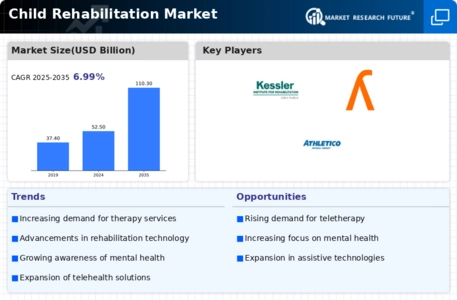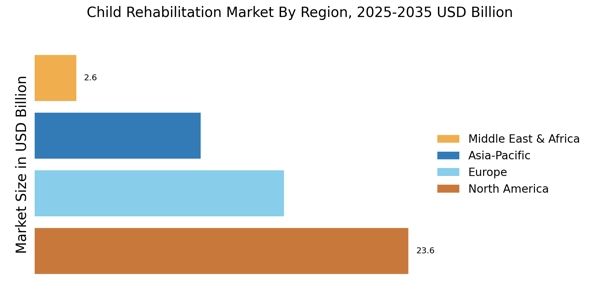Government Initiatives and Funding
Government initiatives aimed at improving healthcare access for children with disabilities are a significant driver of the Child Rehabilitation Market. Various countries have implemented policies and funding programs to support rehabilitation services, recognizing the importance of early intervention and comprehensive care. For example, funding for pediatric rehabilitation programs has increased, allowing for the establishment of more facilities and the hiring of specialized staff. These initiatives not only enhance service availability but also promote awareness and education regarding the needs of children with disabilities. As governments continue to prioritize child health and rehabilitation, the market is likely to experience sustained growth, with increased investment in infrastructure and services that cater to this vulnerable population. The Child Rehabilitation Market stands to benefit from these supportive policies, which may lead to improved outcomes for children in need.
Advancements in Rehabilitation Technology
Technological advancements play a pivotal role in shaping the Child Rehabilitation Market. Innovations such as virtual reality, robotics, and telehealth are transforming traditional rehabilitation methods, making them more effective and accessible. For instance, the integration of virtual reality in therapy sessions has shown promising results in engaging children and enhancing their motivation to participate in rehabilitation activities. Moreover, telehealth services have expanded access to rehabilitation professionals, particularly in underserved areas, allowing for timely interventions. The market is witnessing a surge in investments directed towards research and development of new technologies aimed at improving rehabilitation outcomes. As these technologies continue to evolve, they are likely to redefine the landscape of the Child Rehabilitation Market, offering new avenues for growth and improved patient experiences.
Rise in Parental Involvement and Advocacy
The growing trend of parental involvement and advocacy in the rehabilitation process is emerging as a key driver for the Child Rehabilitation Market. Parents are increasingly taking an active role in their children's rehabilitation journeys, seeking out information, resources, and support networks. This shift is fostering a more collaborative approach to rehabilitation, where parents work closely with healthcare professionals to tailor interventions that meet their children's unique needs. Additionally, advocacy groups are raising awareness about the importance of rehabilitation services, pushing for better access and quality of care. As parents become more informed and engaged, they are likely to demand higher standards of care and more innovative rehabilitation solutions. This trend not only enhances the effectiveness of rehabilitation programs but also contributes to the overall growth of the Child Rehabilitation Market, as it encourages the development of services that are responsive to the needs of families.
Growing Awareness of Mental Health in Children
The increasing recognition of mental health issues among children is significantly influencing the Child Rehabilitation Market. Mental health disorders, such as anxiety and depression, are becoming more prevalent, prompting a need for comprehensive rehabilitation services that address both physical and psychological aspects of recovery. Recent studies indicate that nearly 1 in 5 children experience mental health challenges, which underscores the urgency for effective rehabilitation programs. This growing awareness has led to the development of integrated care models that combine physical rehabilitation with mental health support, thereby enhancing overall treatment efficacy. As stakeholders, including parents, educators, and healthcare providers, become more attuned to the importance of mental health, the demand for specialized rehabilitation services is expected to rise, further propelling the Child Rehabilitation Market.
Increasing Prevalence of Pediatric Disabilities
The rising incidence of pediatric disabilities is a crucial driver for the Child Rehabilitation Market. According to recent statistics, approximately 15% of children worldwide experience some form of disability, which necessitates specialized rehabilitation services. This growing population of children with disabilities creates a heightened demand for tailored rehabilitation programs. As awareness of these conditions increases, parents and caregivers are more likely to seek professional help, thereby expanding the market. Furthermore, the emphasis on early intervention strategies has led to an increase in the number of rehabilitation facilities and services available, which is likely to further stimulate market growth. The Child Rehabilitation Market is thus positioned to respond to this increasing need, potentially leading to innovations in service delivery and program development.


















Leave a Comment